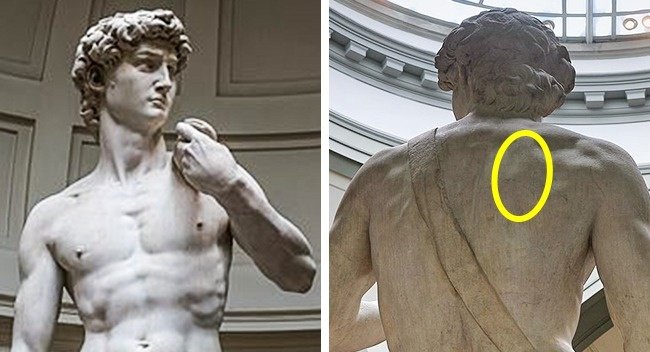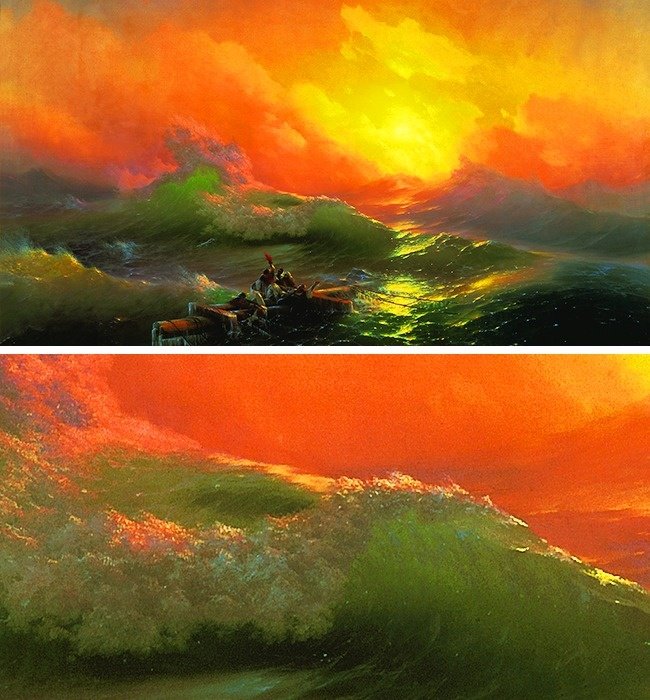8 sculptural masterpieces that contain little-known secrets
Each sculpture masterpiece contains hidden secrets. A true masterpiece always proves its appeal. It makes you admire and think that only genius can create a perfect beauty from an inanimate rock. However, there are still some quite funny mysteries that you don't know about.
People can make mistakes and even geniuses cannot avoid it. On the Bright Side page there is a new look at world-famous art masterpieces and uncovered some inaccuracies, whether accidentally or intentionally. Please join us to consult the 8 sculptural masterpieces that contain secrets that few people know about in the article below!
8. Michelangelo's David Statue
 © Jörg Bittner Unna / commons.wikimedia © Jörg Bittner Unna / commons.wikimedia
© Jörg Bittner Unna / commons.wikimedia © Jörg Bittner Unna / commons.wikimedia
Statue of David is a statue sculpted by Michelangelo from 1501 to 1504 - a masterpiece of Renaissance sculpture and one of Michelangelo's two greatest sculptures. This statue is seen as a symbol of youthful beauty and strength.
Statue of David - the hero in the Bible carved from a single Carrara stone. Michelangelo's sculptures are usually highly accurate in terms of body, but the statue of David has a small hole : a piece of muscle lost between the spine bone and the right shoulder blade. The sculptor cannot carve it because of a blemish in marble.
7. "The Ninth Wave - The Ninth Wave" by Ivan Aivazovsky
 © commons.wikimedia
© commons.wikimedia
Ivan Aivazovsky's " The Ninth Wave - The Ninth Wave " depicts a group of shipwreck victims, all of whom are about to be engulfed by a giant wave. A cruel blow of natural power, the waves of waves, surging up violently and falling down with tremendous power, revealed a moment of deep pools below. The constant movement of clouds and bubbles, further increased the impression of a raging sea storm.
Painter Ivan Aivazovsky observed this scene from the coast and thought that all waves on the sea were the same. However, waves arising in sea storms are cone-shaped and look different from waves in the river section.
6. Michelangelo's Moses statue
 © Jörg Bittner Unna / commons.wikimedia
© Jörg Bittner Unna / commons.wikimedia
The Moses statue is the famous sculpture of Michelangelo - the Renaissance artist and sculptor.
A famous anecdote states that, after finishing the Moses statue, Michelangelo banged his hammer on the statue's knee and exclaimed: " Why don't you talk to me? ". Also, the Moses statue is like the real thing. However, the story will be nothing to say, if the statue of Moses does not own a pair of horns .
Many painting historians have argued that Michelangelo misunderstood the Bible . There is a passage in the Bible: " It is difficult for the Jews to admire the face of Moses when he descended at Mount Sinai with a stone tabletop." The Hebrew word " karnayim " appears to have been misunderstood as " horn " when translated into Italian and so the Moses statue possesses a beautiful pair of horns, unrelated.
5. The painting "A Bar at the Folies-Bergere" by Édouard Manet
 © commons.wikimedia
© commons.wikimedia
The painting " A Bar at the Folies-Bergere " by Édouard Manet on the Courtauld Gallery in London has been discussed a lot. The bar girl in Manet's picture did not look directly at the viewer but looked with a sad, tired face . She was unfamiliar with the surrounding scenery full of details, trying to ignore the sleazy customers, including a sinister and confusing man in the mirror. Work is a string of unnamed things, dangerous gender relations and the magnificent city of Paris is like an empty nightclub in Manet's view at the time. Because of that, all of those things show up in the face of the young girl.
If you look in the mirror, you can immediately see the reflection is not true : the bottles on the counter are placed in different positions and the waiter seems to be looking in a different direction. In the painting, there is a young woman standing in front of a large mirror, because we see the back reflected, but this reflection does not completely reflect the normal angle and this back is facing a the man standing before her.
The viewer seemed to stand opposite her face selling alcohol outside the counter, looking at what reflected through a mirror. However, when you look closely, you can ask yourself, where do you see the picture standing? Is the position of the man in the upper right corner outside the counter in front of the mirror of the painting? And who is the man in the painting? That is the painter Édouard Manet.
4. Rembrandt's 'Night watch - Night patrol'

 © commons.wikimedia
© commons.wikimedia
Rembrandt's ' Night watch ' picture is full of questions that have no answers. There is a lot of debate about the gloves of Captain Frans Banning Cocq : the gloved hand on the right hand is holding another glove. Many art historians think this is a way to bring humor to the painting. Others claim that the glove is the left glove, and the captain holds it with the ring finger while the thumb is pointing towards the viewer.
3. 'The Supper at Emmaus' by Caravaggio

 © commons.wikimedia
© commons.wikimedia
Viewers who pay close attention can observe that the basket of fruits is " clinging " on the edge of the table but does not fall, challenging the laws of physics. Besides, art experts pay more attention that the fruits in the basket do not seem to be the right season: the picture is painted the night before Easter, before the fall harvest. All these mistakes are deliberate: apples, grapes as well as fish balls of fruit baskets, carrying Christian symbols and evangelical documents.
See also: Only the genius finds all the differences in these 16 photos!
2. "The Birth of Venus - Botticelli's Birth "

 © commons.wikimedia
© commons.wikimedia
Sandro Botticelli is an Italian genius painter in the pre-Renaissance era. " The Birth of Venus " is his greatest work and is considered a symbol of ' Truth - Compassion - America '. In Greek mythology, Venus was born from the sponge, the son of the Lord of the sky - Uranus. The birth of the Venus Goddess became a great topic in painting, there are very famous paintings of Cabanel, Bouguereau or Amaury Duval.
However, the picture of Sandro Botticelli is still widely recognized as the most perfect and classic work. In the painting, the Venus goddess is depicted with bright golden hair, white skin, holy face and berry lips. Besides, Venus has a plump, plump, energetic body that symbolizes birth, love, joy and beauty.
Although Renaissance sculpture is thought to be highly anatomically accurate, Venus still has notable shortcomings, such as a swollen and long neck . According to an opinion, these mistakes are intentional to avoid describing a woman's perfect body.
1. "The Sistine Madonna - Mother Sistine" by Raphael
 © commons.wikimedia.
© commons.wikimedia.
At first glance, you can see the impression that Pope Sixtus II has six fingers on the right hand . However, after looking back more carefully, you will realize that what you see about the sixth finger is part of the palm. The development next to Madonna's youngest toes can be a sign of polydactyly - anomalies - a birth defect in humans with toe or finger factors. Although this case usually does not threaten life, or even particularly affects, but most Westerners surgically remove the extra finger.
Do you know the original Mona Lisa by Leonardo Da Vinci?
 Mona Lisa picture.
Mona Lisa picture.
Leonardo da Vinci is an all-powerful Italian genius: an outstanding painter, architect, musician, engineer, a scientist ahead of his time . Undoubtedly, Mona Lisa is a work The most famous painting in the world, considered as the standard of beauty.
The painting depicts a plump woman, seemingly happy, with a soft smile . Later, trying to analyze the mystery of the Mona Lisa 's smile: she was smiling or not smiling, what that smile meant, how Da Vinci could create such a smile . but never give satisfactory answers. Moreover, there are a series of hypotheses and myths surrounding the prototype of the painting.
Very few people know that there is another version of La Gioconda - Isleworth Mona Lisa thought to be painted by artist Da Vinci, although it was painted many years earlier. This image was found in a personal collection more than a century ago and is now on display at the Prado Museum in Madrid. Perhaps it will one day help find answers to questions asked by Mona Lisa?
- Protecting ancient world secrets
- Art masterpieces made of bacteria
- 10 famous architectural masterpieces through the era
- 20 artworks 'say no' to gravity
- Decoding the extremely rare phenomenon behind art masterpieces 'Screams'
- Do you think this is a photograph?
- See masterpieces from 100 000 toothpicks built in 35 years
- The meaning hides in the four Renaissance masterpieces that every noble is knowledgeable about
- Amazingly 5 world masterpieces you may not know yet
- Architectural masterpieces of Maya civilization
- The bridge of architectural masterpieces of the world
- Video: Art of stone balance
 'Fine laughs' - Scary and painful torture in ancient times
'Fine laughs' - Scary and painful torture in ancient times The sequence of numbers 142857 of the Egyptian pyramids is known as the strangest number in the world - Why?
The sequence of numbers 142857 of the Egyptian pyramids is known as the strangest number in the world - Why? History of the iron
History of the iron What is alum?
What is alum?